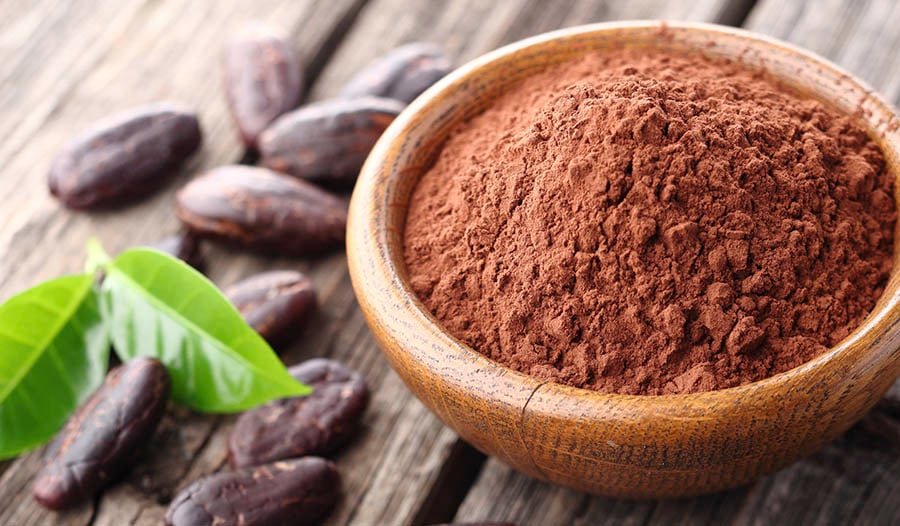Cacao: beneficii, sănătate cardiacă, funcție cognitivă și multe altele

Boabele cacao sunt sursa poate celor mai magice și iubite alimente de pe Pământ, deoarece este sursa ciocolatei. Chiar și numele oficial al arborelui de cacao, Theobroma cacao, recunoaște dragostea de lungă durată pe care majoritatea dintre noi o avem pentru fructele acestui copac. Theobroma provine din limba greacă pentru „hrana zeilor”. Și în timp ce ciocolata este cea mai populară și preferată dintre aceste alimente din boabele de cacao, o alegere și mai sănătoasă este pudra de cacao crudă.
Cum se face pudra de cacao?
Pentru a produce pudră de cacao crudă, boabele de cacao crude sunt presate la rece pentru a îndepărta grăsimea, iar restul solidelor sunt măcinate într-o pulbere fină.
Cacao vs. Cacao: Care este diferența?
Pudra de cacao conține toți nutrienții benefici și compușii benefici ai boabelor de cacao crude minus grăsimea. În schimb, pudra de cacao este făcută din boabe de cacao prăjite. Și chiar dacă arată la fel, cele două sunt diferite. La fabricarea pudrei de cacao, până la 90% din nutrienții și compușii benefici din boabele de cacao crude sunt îndepărtați.
Pudra de cacao este produsă din boabe de cacao care sunt fermentate, uscate și prăjite la foc mare. Și în metoda olandeză de prelucrare, fasolea este spălată inițial cu o soluție alcalinizantă care conține carbonat de potasiu, carbonat de sodiu și/sau hidroxid de sodiu. Scopul este de a elimina componentele amare, ceea ce epuizează în continuare beneficiile pentru sănătate.
Procesul olandez reduce conținutul total de flavonoide cu 60%. Boabele sunt măcinate într-o pastă pentru a separa și îndepărta untul de cacao cu sau fără alcalinizare. Solidele rămase sunt măcinate într-o pulbere fină. În procesul de fabricare a pudrei de cacao, nutrienții și beneficiile pentru sănătate sunt pierdute semnificativ.
Cacao este bogat în flavonoide
Efectele benefice ale pudrei de cacao crude se datorează în primul rând conținutului său de flavonoide, care reprezintă până la 48% din greutatea uscată a boabelor de cacao. Prin comparație, pudra de cacao conține doar 10% flavonoide. Cincisprezece grame (aproximativ două linguri) de pudră de cacao crudă oferă mai mult de 400 mg de flavonoide, în timp ce aceleași 15 grame de pudră de cacao pot conține doar 78 mg.
Flavonoidele cheie din pudra de cacao sunt flavanoli precum cei din ceaiul verde și proantocianidinele ca cele din multe fructe de pădure și extracte de semințe de struguri și scoarță de pin.
Există, de asemenea, compuși în cacao care cresc absorbția flavonoidelor. În principal, este raportul unic de grăsimi saturate sănătoase pentru inimă, care nu cresc nivelul colesterolului. Fibra dietetică prebiotică promovează, de asemenea, efecte benefice asupra compoziției microbiomului intestinal, sporind absorbția polifenolilor de cacao.
Pudra de cacao este, de asemenea, bogată în nutrienți care promovează sănătatea inimii, cum ar fi magneziu și arginina , aminoacidul care produce oxidul nitric compus în vasele de sânge pentru a ajuta la controlul funcției vasculare și prevenirea formării cheagurilor.
Beneficiile pentru sănătate ale cacaoului
Cele mai multe cercetări privind alimentele care conțin flavonoide de cacao s-au concentrat pe sănătatea creierului și a inimii. Iată un rezumat al acestor beneficii:
- Stimulează fluxul de sânge către creier.
- Îmbunătățește funcția creierului prin îmbunătățirea căilor de semnalizare care promovează conectivitatea creierului.
- Promovează sănătatea mucoasei vasculare.
- Protejează împotriva deteriorării oxidative a colesterolului și a mucoasei arterelor.
- Preveniți aglomerarea excesivă a trombocitelor din sânge care provoacă cheaguri de sânge.
Beneficiile inimii de cacao
Unul dintre modurile critice prin care flavonoidele de cacao produc aceste efecte este prin îmbunătățirea sănătății și funcției celulelor care căptușesc vasele de sânge. Toate vasele de sânge, de la capilarele minuscule până la aortă, au o căptușeală compusă din celule endoteliale. Dacă toate celulele endoteliale ale corpului ar fi așezate plat, acestea ar avea o suprafață aproape de dimensiunea unui teren de fotbal.
Disfuncția endotelială este o problemă critică în bolile cardiovasculare și se găsește în toate condițiile asociate cu funcția vasculară slabă, cum ar fi ateroscleroza, hipertensiunea arterială și diabetul. Ceea ce cauzează această disfuncție endotelială este deteriorarea cauzată de toxine (de exemplu, fumul de țigară), nivelurile ridicate de zahăr din sânge și deteriorarea datorată pro-oxidanților, cum ar fi colesterolul LDL oxidat.
Flavonoidele de cacao pot ajuta la prevenirea acestei deteriorări și pot promova capacitatea celulei de a produce oxid nitric, o substanță chimică cheie pe care sistemul vascular o folosește pentru a promova flexibilitatea vasculară, fluxul sanguin adecvat și prevenirea formării cheagurilor.
Beneficiile creierului cacaoului
Multe cercetări s-au concentrat asupra efectelor benefice ale preparatelor de cacao asupra sănătății creierului și a funcției cognitive. Majoritatea studiilor au folosit pudră de cacao, dar după cum sa subliniat mai sus, pudra de cacao conține concentrații mult mai mari de compuși cheie și ar trebui să producă rezultate și mai bune.
Studiile cu pudră de cacao au utilizat o varietate de teste standardizate care evaluează memoria, atenția, luarea deciziilor, înțelegerea înțelegerii limbajului și alte măsuri ale proceselor mentale. Au existat cincisprezece studii dublu-orb care au comparat produsele din cacao au fost comparate cu un placebo sau un produs cu cacao cu conținut scăzut de flavanol. Dintre aceste cincisprezece studii, zece au arătat efecte pozitive semnificative asupra funcției creierului, în timp ce cinci nu au prezentat efecte semnificative.
Cu toate acestea, este important de menționat că, chiar și în studiile în care nu a putut fi demonstrată o îmbunătățire a cunoașterii, au existat alte măsuri care au arătat îmbunătățiri, cum ar fi o reducere a oboselii mentale, scăderea timpului de reacție, creșterea vitezei de procesare, creșterea fluxului sanguin cerebral sau a volumului în anumite zone ale creierului și niveluri crescute de compuși benefici ai creierului.
Doza de flavanoli de cacao în aceste cincisprezece studii a variat de la o doză mică (de exemplu, 50 mg pe zi) până la 994 mg pe zi. Durata acestor studii a variat de obicei de la una la trei luni.
Beneficiile flavanolilor de cacao sunt observate la vârstnici și la adulții mai tineri. Și uneori, efectele sunt observate în decurs de două ore după ingestie. Cu toate acestea, nivelurile mai mari de dozare și durata mai lungă au produs, în general, rezultate mai bune atât la subiecții bătrâni, cât și la cei tineri.
Într-unul dintre cele mai bine concepute studii, subiecții sănătoși în vârstă care au consumat o băutură de cacao cu un conținut ridicat de flavanol (900 mg) timp de 3 luni au prezentat un volum mai mare de sânge într-o zonă cheie a creierului (girusul dentat) asociată cu memoria. În general, pe măsură ce oamenii îmbătrânesc, există o scădere atât a fluxului sanguin, cât și a funcției în această regiune a creierului. Creșterea volumului de sânge în această zonă produsă de ingestia de flavanol de cacao a fost legată de performanța îmbunătățită a unei sarcini de memorie specifice acestei zone. Alte studii au arătat măsuri obiective suplimentare dincolo de fluxul sanguin care susțin flavanolii de cacao producând un efect general asupra sănătății creierului. De exemplu, mai multe studii au arătat că flavanolii de cacao cresc factorul neurotrofic derivat din creier (BDNF) la adulții mai în vârstă și mai tineri. Acest compus stimulează formarea de noi celule cerebrale pentru a înlocui celulele creierului deteriorate sau vechi.
Cacao crud conține cofeină?
Da, pudra de cacao crudă conține cafeină și chiar mai mult dintr-un compus similar cunoscut sub numele de teobromină. Marea diferență este că teobromina este de aproximativ zece ori mai slabă decât cofeina în producerea unui efect stimulant. O porție de două linguri de pudră de cacao crudă oferă aproximativ 40 mg de cofeină, puțin mai puțin de jumătate din ceașcă de cafea și aproximativ 200 mg de teobromină. În general, efectul stimulant al două linguri de cacao crud este aproximativ același cu o jumătate de cești de cafea.
Cum se utilizează pudra de cacao
Folosirea pudrei brute cacao poate fi cel mai simplu și mai rentabil mod de a adăuga flavonoidele benefice de cacao în dieta ta. Iată câteva sugestii:
- Adăugați două linguri de pudră de cacao crudă în smoothie-urile dvs. Dacă trebuie să-l îndulciți, adăugați aluloză, xilitol, îndulcitor de fructe de călugărsau stevia după gust.
- Adăugați o lingură de pudră de cacao crudă și curmale tocate într-o porție de iaurt grecesc simplu.
- Presărați pudră de cacao peste fructele proaspete preferate. Afinele, căpșunile, ananasul și bananele sunt alegeri excelente.
Rețetă de băutură fierbinte de cacao
Și iată modul meu preferat de a introduce pudră de cacao crudă în zilele mele. Încep procesul încălzind laptele de migdale sau nucă de cocos, apoi îl turn într-o cană mare. Apoi adaug două-trei linguri de pudră de cacao și o lingură de aluloză (puteți folosi și xilitol sau eritritol). Apoi folosesc un mic mixer de mână pentru a amesteca. Și de multe ori, voi spori aroma băuturii mele speciale adăugând 1 lingură de ulei de nucă de cocos, 1⁄2 până la 1 lingură de scorțișoară, 1⁄4 până la 1⁄2 linguriță de nucșoară, două picături de extract de vanilie, două picături de ulei de mentă.
Referințe:
- Montagna MT, Diella G, Triggiano F, Caponio GR, De Giglio O, Caggiano G, Di Ciaula A, Portincasa P. Ciocolată, „Mâncarea zeilor”: istorie, știință și sănătate umană. Int J Environ Res Sănătate publică. 2019 decembrie 6; 16 (24): 4960.
- Andres-Lacueva C, Monagas M, Khan N, Izquierdo-Pulido M, Urpi-Sarda M, Permanent J, Lamuela-Raventos RM. Conținutul de flavanol și flavonol din produsele din pudră de cacao: influența procesului de fabricație. J Agric Food Chem. 2008 14 mai; 56 (9): 3111-7.
- Goya L, Kongor JE, de Pascual-Teresa S. De la cacao la ciocolată: efectul procesării asupra flavanolilor și metilxantinelor și mecanismele lor de acțiune. Int J Mol Sci. 2022 noiembrie 18; 23 (22) :14365.
- Martin MÁ, Ramos S. Impactul flavanolilor de cacao asupra sănătății umane. Food Chem Toxicol. 2021 mai; 151:112121.
- Tan TYC, Lim XY, Yeo JHH, Lee SWH, Lai NM. Efectele asupra sănătății ciocolatei și cacaoului: o revizuire sistematică. Nutrienți. 2021 24 august; 13 (9): 2909.
- Sun Y, Zimmermann D, De Castro CA, Actis-Goretta L. Relația doză-răspuns între flavanolii de cacao și funcția endotelială umană: o revizuire sistematică și meta-analiză a studiilor randomizate. Funcția alimentară 2019 octombrie 16; 10 (10): 6322-6330.
- Barrera-Reyes PK, de Lara JC, Gonzalez-Soto M, Tejero ME. Efectele polifenolilor derivați din cacao asupra funcției cognitive la om. Revizuirea sistematică și analiza aspectelor metodologice. Alimente vegetale Hum Nutr. 2020 martie; 75 (1): 1-11.
- Zeli C, Lombardo M, Storz MA, Ottaviani M, Rizzo G. Ciocolată și biomolecule derivate din cacao pentru cunoașterea creierului în timpul îmbătrânirii. Antioxidanți (Basel). 2022 iulie 12; 11 (7) :1353.
- Martín MA, Goya L, de Pascual-Teresa S. Efectul produselor de cacao și cacao asupra performanței cognitive la adulții tineri. Nutrienți. 30 noiembrie 2020; 12 (12): 3691.
- Brickman AM, Khan UA, Provenzano FA, Yeung LK, Suzuki W, Schroeter H, Wall M, Sloan RP, Small SA. Îmbunătățirea funcției girusului dentat cu flavanoli dietetici îmbunătățește cunoașterea la adulții în vârstă. Nat Neurosci. 2014 decembrie; 17 (12): 1798-803.
Declarație de declinare a responsabilității:Acest blog nu are ca scop să ofere un diagnostic.













































































 Cuprins
Cuprins
















